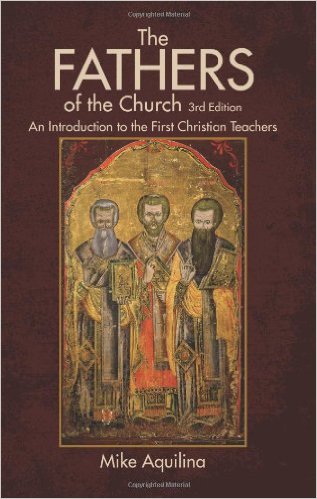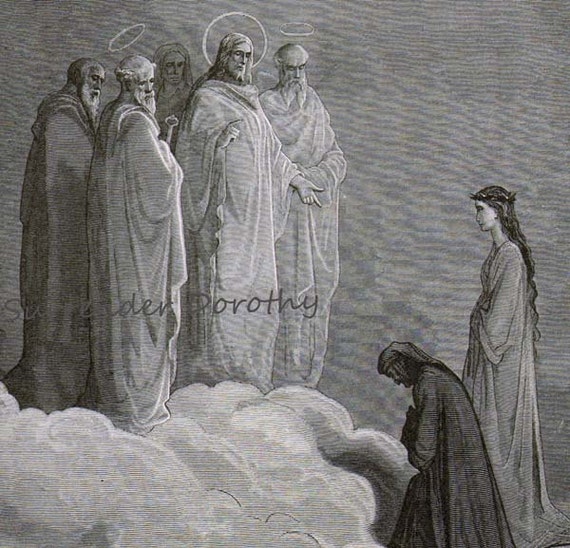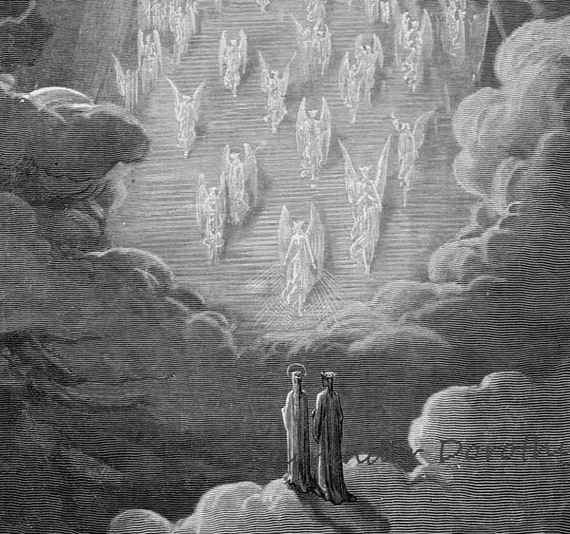Canto
XXIII may be the most beautiful canto in the entire Commedia, and that’s saying a lot.
It’s worth looking at it in a close reading. It’s a canto known for its seven similes, two
simple comparisons, and I’ve noticed a metaphor or two as well. First let me highlight a few of the narrative
details and then I’ll look at each of the seven similes.
We
start the canto with Beatrice suspended in the sky and looking heavenward. She points to Christ above who is in a
triumph. A triumph is a specific ancient
Roman victory celebration where the victorious general is given a public
commemoration. As part of the ceremony,
the man of honor was given a laurel for his head, and, dressed in a golden toga,
took a victory lap in a chariot. That is
how to picture Christ’s triumph. It is a
triumphant ride across the sky, and it also represents the Church
Triumphant. This is one of the three
Church aspects, Militant (in its role to combat sin and heresy), Penitent (in
its role to forgive sins), and Triumphant (in its role to celebrate
salvation). Both Church Militant and
Penitent are roles the Church has on earth; Triumphant is a role in
heaven. The closing quatrain of the
canto summarizes this.
Beneath the exalted Son
of God and Mary,
up there he triumphs in
his victory,
with souls of the
covenants old and new,
the one who holds the
keys to such great glory.
(XXIII.136-139)
Christ,
in the triumph, is portrayed as bright as the sun. Dante (the character) looking at the intense
brightness goes momentarily blind. This
is the first of the several instances of Dante going blind in this group of
cantos. I’ll have more to say on the
various times he goes blind when I comment on the other cantos, but here the
intensity of Christ’s light is emphasized.
It is notable that it is Christ’s light that illuminates the other
souls, just as the sun illuminates the world.
Beatrice
implores Dante to open his eyes and see her fully. “The things that you have witnessed,” she
says, “have given you strength to bear my smile!” So since he couldn’t see her smile a few
cantos back or he would burnt up, here Dante has graduated to a greater ability
to withstand God’s intensity. He too has
been increasing in grace.
Beatrice
then points to a rose in the heavens, which is the Blessed Virgin. Associated with the rose because of the
flower’s beauty and complexity, the Holy Queen is sometimes called the Mystic
Rose. When the archangel Gabriel comes
down as a lit torch and circles the head of the Blessed Mother, we have the
enactment of her coronation. Is this a
dramatization for Dante’s sake or is this a constant, eternal drama? It doesn’t say, but now every time I get to
the fifth mystery of the Glorious Mysteries of the rosary, I will forever have
this image in mind.
The
drama in this canto is stunning, but let’s look at the poetry through the seven
similes. The first is right at the
opening of the canto describing Beatrice staring at the sky.
As the bird among the
leafy branches that she loves,
perched on the nest with
her sweet brood
all through the night,
which keeps things veiled from us,
who in her longing to
look upon their eyes and beaks
and to find the food to
nourish them --
a task, though difficult,
that gives her joy –
now, on an open bough,
anticipates that time
and, in her ardent
expectation of the sun,
watches intently for the
dawn to break,
so was my lady, erect and
vigilant,
seeking out the region of
the sky
in which the sun reveals
less haste. (1-12)
Now
that is a Homeric type of simile, one sentence of one hundred words (in
English) spanning four tercets. Dante
does not typically write long sentences.
Here we have the bird imagery, which has been a frequent motif throughout
the Commedia, with Beatrice compared
to a mother bird—perhaps foreshadowing the Blessed Mother who will shortly
appear—looking for the sun, which becomes associated with Christ. The mother bird is looking to nourish her
chicks, and Dante is her chick that needs spiritual nourishment.
The
second simile describes how Christ brightens all around him.
As, on clear nights when
the moon is full,
Trivia smiles among the
eternal nymphs
that deck the sky through
all its depths,
I saw, above the many
thousand lamps,
a Sun that kindled each
and every one
as ours lights up the
sights we see above us,
and through that living
light poured down
a shining substance. (25-32)
In
what should be dark night, the sun reflects across to the moon and lights her
up, so Christ lights up all that is around him.
Trivia is an ancient Roman goddess, but I have to admit I don’t get the
allusion and Hollander doesn’t explain it.
The
third simile compares a thought in his mind to a flash of lightning (lines
40-45). The fourth simile compares
Dante’s inability to fully poetically represent Paradise and so requiring a
leap like man walking and needing to leap over an obstruction (61-63). The fifth simile describes how the throng of
souls are lit up like the sun lights up a field of flowers (79-84).
The
sixth simile describes the transcendent beauty of the heavenly music. During the Coronation, heavenly music is
heard and Dante (the author) describes it in an inverse way.
The sweetest melody,
heard here below,
that most attracts our
souls,
would seem a burst of
cloud-torn thunder
compared with the
reverberation of that lyre
with which the lovely
sapphire that so ensapphires
the brightest heaven was
encrowned. (97-102)
So
the sweetest melody heard on earth would sound like a thunder clap compared to
the beauty of the Paradisic melody.
Notice Dante also adds a metaphor as an extension to the simile. That heavenly hymn is a sapphire which
encrowns heaven. The hymn which is a
sapphire which is a crown connects with the crown which circles the Blessed
Mother.
Finally
the seventh simile describes the apostles reaching out to Mother Mary as
infants reaching for their mother.
And, like a baby reaching
out its arms
to mamma after it has
drunk her milk,
its inner impulse kindled
into outward flame,
all these white splendors
were reaching upward
with their fiery tips, so
that their deep affection
for Mary was made clear
to me. (121-126)
The
fiery tips of the splendors, which are souls, are like the arms of a babe
reaching for its mother. Dante brings
mother down to the colloquial, “mamma.”
And what began the canto as a mother bird awaiting to nourish her brood,
it ends with a mother having nourished her babe.
Truly,
what beauty.
###
Here
are some thoughts and comments on the cantos concerning the Starry Sphere.
The
oral examination under which Dante (the character) is subjected is a brilliant
narrative innovation. I can't recall any
other writer writing before Dante to have used it. First off, it captures the university
experience of the medieval world. Next,
it captures the flow of St. Thomas Aquinas' Summa
Theolgiae in which the Commedia owes much philosophically. Here it reproduces it narratively. Also think of the far reaching influence of
this narrative technique. We see such
interrogative dramatizations all the time, most noticeably in crime dramas and
legal suspense stories.
The
oral examination captures the mediaeval university experience so well that it
makes me wonder if Dante (the author) actually attended a university. No such event is recorded. Presumably then Dante had access to many university
texts, especially that of Thomas Aquinas.
The
oral exam also brings one of the ongoing motifs to a conclusion. Throughout the Commedia, Dante (the character) has been learning. He is on a journey to acquire knowledge, and
before he can complete the journey we see what he has learned put to the
test. When lost in the woods of life as
seen way back before he entered the underworld, Dante (the character) was in a
spiritual crises, and what we have seen is that despite having gain great
knowledge of all sorts of things, when Beatrice died he lost his understanding
of the Christian virtues of faith, hope, and charity. Through his journey he has seen what the
three virtues mean, either because they are absent in some (Inferno), struggling to regain in others
(Purgatorio), or celebrated in still
others (Paradiso).
The
spirits that test Dante are the three apostles of Christ's inner circle, saints
Peter, James, and John. Dante
appropriately picks the apostle who in some way was associated with the virtue
they question Dante on. Peter, who
famously denied Christ but had faith enough to walk on water, at least
momentarily, wrote a magnificent letter (First Epistle) on the perseverance of
faith under suffering. St. James, on
whose burial place in Compostella pilgrims go to pray with petitions, examines
Dante on hope, which is what prayer expresses.
And St. John the Evangelist wrote several letters on the virtue of love.
It
is interesting how Beatrice interacts within all three of Dante’s examinations. In her exchange with Peter, she acknowledges
that Peter already knows Dante’s knowledge on faith, hope, and love, but he
should be made to articulate it for God’s glory:
And she: 'O everlasting
light of that great man
with whom our Lord did
leave the keys,
which He brought down
from this astounding joy,
'test this man as you see
fit on points,
both minor and essential,
about the faith
by which you walked upon
the sea.
'Whether his love is
just, and just his hope and faith,
is not concealed from you
because your sight
can reach the place where
all things are revealed.
'But since this realm
elects its citizens
by measure of true faith,
it surely is his lot
to speak of it, that he
may praise its glory.' (XXIV.34-45)
Peter’s
questioning is capped off with a mini credo at the end of the canto
(XXIV.130-147), but the last two tercets capture Dante’s exam answers in two
wonderful metaphors.
The profound truth of
God's own state of which I speak
is many times imprinted
in my mind
by the true instructions
of the Gospel.
'This is the beginning,
this the living spark
that swells into a living
flame
and shines within me like
a star in heaven.' (142-147)
God
is imprinted in his mind through the Gospels, and from that little spark his
faith grows into a flame which shines within him like a star in heaven. Beautiful.
The
canto where Dante (the character) is quizzed on hope, Dante (the author),
intruding into the narrative, begins with an earthly hope.
Should it ever come to
pass that this sacred poem,
to which both Heaven and
earth have set their hand
so that it has made me
lean for many years,
should overcome the
cruelty that locks me out
of the fair sheepfold
where I slept as a lamb,
foe of the wolves at war
with it,
with another voice then,
with another fleece,
shall I return a poet
and, at the font
where I was baptized,
take the laurel crown. (XXV.1-9)
He
hopes that the beauty of this poem, the Divine
Comedy, will someday allow Florence to renounce his exile and allow him
back to receive a laurel crown as poet.
This can be seen in at least two ways.
First, it foreshadows and echoes the canto’s theme of things hoped for,
but it also contrasts his earthly hope with the spiritual hope of
salvation. In fact, it makes the earthly
hope appear so much less in comparison.
When Dante is writing these lines, it is well into his exile and toward
the end of his life. He probably
realized that such a hope would never materialize, and so in a way he is
belittling his pride that he would have such a hope when the hope of eternal
salvation is at hand. Heavenly glory is
by far more important than this earthly glory.
St.
James quizzes Dante on hope. The New
Testament identifies three men as James.
There is James Zebedee, the brother of John, there is another apostle
with the name James, and he is usually referred to as James the Lesser. And in Acts
there is James the head of the church in Jerusalem, who is referred to as James
the Brother of Jesus. James the Lesser
and James the Brother of Jesus are to some considered the same person. But nonetheless this James is not the brother
of John. The James here in the canto is
identified as the one whose bones are in Compostella (18), which indicates that
he is James Zebedee. But when Beatrice
addresses him, as the one “who wrote/of the abundant gifts of our heavenly
court” (29-30), which indicates this is the James who wrote the New Testament
Epistle under his name. But the epistle
was written by the other James if you count two or the Brother of Jesus if you
count three. So Dante is either ignorant
of the distinction or has something in mind by conflating the two. I fail to see any reason for the conflation,
so I lean to a mistake.
Before
Dante provides an answer on what rests his hope, Beatrice interjects that she
knows no other person so filled with hope as Dante (52-54). On what basis does she make this
assertion? Well, think about it. Dante first fell in love with Beatrice when
he was nine years old. He has been
hoping for the fulfillment of this love for many years and across earthly life
and the afterlife. Yes, he has certainly
demonstrated such hope.
Throughout
the questioning from St. John on love, Dante is unable to see. This is the culmination of several instances
of loss of sight while in the Starry Sphere.
The closer Dante journeys to God, the more intense the light. Each time he loses his sight, when he regains
it his eyes are stronger for the next vision.
Each instance is a strengthening, like an exercise.
The
first time he loses his sight in the Starry Sphere is in Canto XXIII when he
looks up to see a vision of Christ triumphant.
When he regains that sight, his eyes are now strong enough to see
Beatrice’s smile. The second time is in
Canto XXV when saints Peter and James stand together and their collective light
overwhelms Dante. James tells Dante to
look up and take hope, and that restores his sight. The third loss of sight in Starry Sphere is
when John approaches and Dante tries to discern if John is in the glory of a
body. The blindness begins at the end of
Canto XXV and stretches all the way through the middle of Canto XXVI when Dante
completes his exam on love without being able to see. It is through the power of Beatrice’s voice
that Dante then regains his sight.
As soon as I was silent,
the sweetest song
resounded through that
heaven, and my lady
chanted with the others:
'Holy, holy, holy!'
As sleep is broken by a
piercing light
when the spirit of sight
runs to meet the brightness
that passes through its
filmy membranes,
and the awakened man
recoils from what he sees,
his senses stunned in
that abrupt awakening
until his judgment rushes
to his aid –
exactly thus did Beatrice
drive away each mote
from my eyes with the
radiance of her own,
which could be seen a
thousand miles away,
so that I then saw better
than I had before. (XXVI.67-79)
Upon
completing his answer, the heavens sound with the Sanctus hymn, and Beatrice’s voice singing along stimulates his
vision like a person being awakened. The
scene alludes to Saul’s transformation to Paul. Just as Ananias of Damascus was
used to restore Saul’s sight (Acts 9:10-18), Beatrice is used to restore
Dante’s sight, whereby now he can see “better” than ever.
The
first thing he sees when he regains his sight is another spirit approaching, this
time Adam. It’s not clear why
narratively Adam approaches now. He
seems out of place with the three apostles, but Dante makes thematic use of it. The first thing Dante sees is the first human
being, and so Dante (the author) gives us a breadth of scope from the beginning
of all time to the present, from the first man to the current. Now only is the timeline linear, but also
circular. Dante’s questions of Adam’s
time seem to emphasize this.
Dante’s
question on the original language is certainly one that would concern a poet,
especially a poet who is writing in the vernacular. Apparently Dante had once believed that
Hebrew was the original language spoken by Adam and Eve, but here we are now
told differently. That original language
has gone extinct, and as Adam implies so does language. This connects with Dante’s vernacular Italian
being the outgrowth of its Latin roots.
Just as Adam is Dante’s “father” here, Adam’s language is ultimately
progenitor to the contemporary languages.
Finally,
Dante’s question of why Adam was expelled from heaven seems curious, since the
Biblical story is well known, but Adam’s answer is even more peculiar. Adam doesn’t say he was expelled for
disobeying God or for eating the apple, which is what we would expect. He says he was expelled for “trespassing”
(XXVI.117). In effect he trespassed on
God’s prerogative. This echoes back to Inferno where Ulysses sails beyond human
boundaries to God’s ire. Adam also
refers to his time away from heaven as an “exile” (116). This connects the two men in their dislocated
histories.










